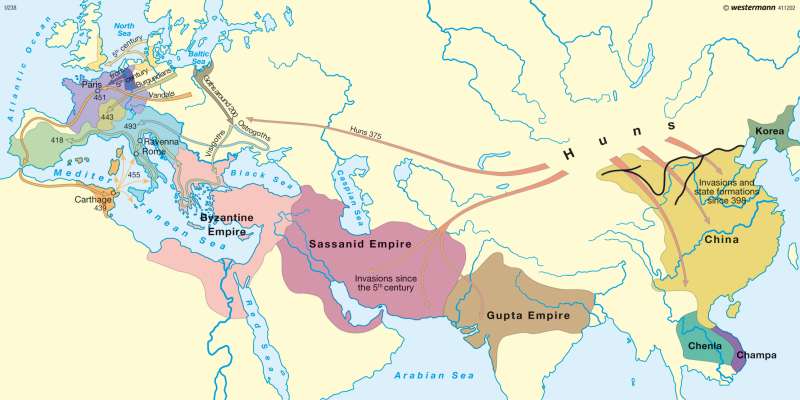Invasions and empires (before the death of Theoderic in 526)
Europe - Classical Antiquity
978-3-14-100790-9 | Page 29 | Ill. 4

Information
The migratory movements of Germanic tribes and peoples between the 2nd and 6th century are referred to as migrations of peoples. The first of these mass migrations began near the end of the 2nd century, when Goths from the Baltic Sea region moved into the region now occupied by the Ukraine. This first wave of migration came to a virtual standstill toward the close of the 3rd century. The major mass migrations in Europe during the 4th and 5th centuries were initiated by the Huns, nomadic tribes from the region of the present Mongolia, who were driven from their homeland by the Chinese in 35/36 AD following a long period of war. They settled initially at the Aral Sea. In 374 AD, they advanced from the steppes of Eastern Europe to attack the Alans, who occupied lands near the Black Sea and whom they eventually conquered. A year later they defeated the Germanic Ostrogoths and forced them, and somewhat later the Gepides, into vassalage.Driving the Gothic tribes ahead of them, the Huns advanced to the Danube. Their triumphal march unleashed a mass migration of numerous Germanic peoples and tribal federations (Vandals, Franks, Burgundians, Saxons, Angles, Jutes, Alemanni, Suebi, Heruli and Gepides). In the course of a long series of battles waged all over Europe, they conquered numerous regions and empires, many of which were short-lived.
The Goths
The Goths were a branch of a Germanic tribe that originally came from Scandinavia. In what is now the Ukraine, they split into two groups, the Visigoths and the Ostrogoths. While




